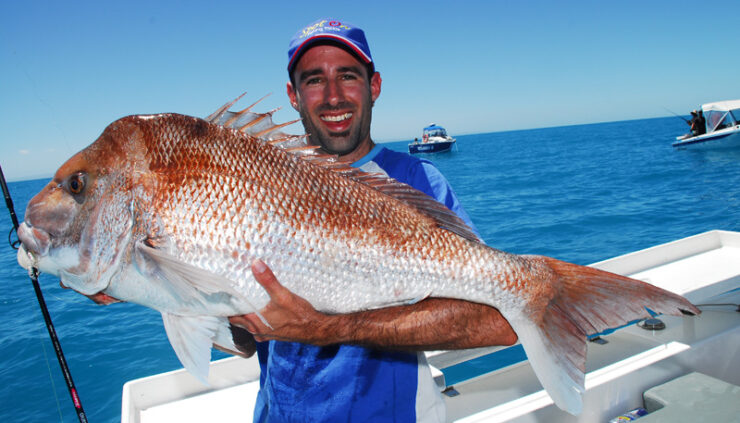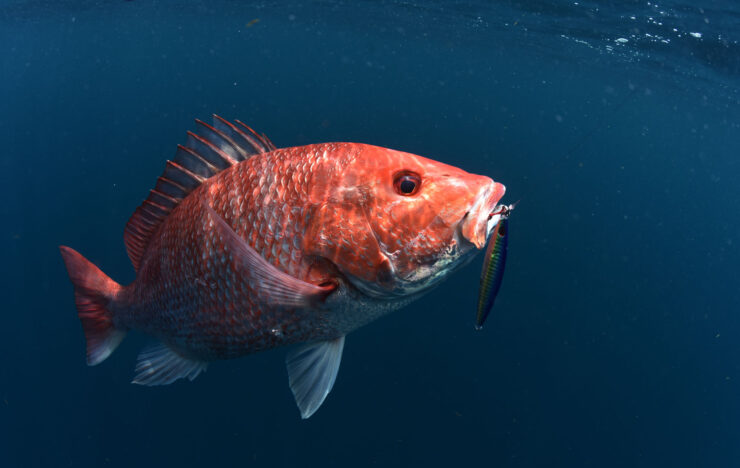In the old days of snapper fishing, success was measured by how many ice chests were filled up. Sadly those days are now gone. Snapper numbers are down and with the introduction of new regulations and restrictions the old fishing techniques no longer work. With the limit on Red Snapper set at only 4 per person, anglers need to make the most of those 4; that means targeting sow snapper. The old system of squid or fish cut up into small chunks with 2 or 3 hooks per line and a huge weight at the end should be retired and only brought out when you want to remember the good ole days. Todays equipment and techniques should be different.
Here are some tips and advice that increase the odds of catching a few big sow snapper:
First in order to catch big snapper you must fish where there are big snapper. So where are the big snapper, you ask? Well big snapper act differently than small snapper but they aren’t overly smart. So you must fish where the fish have a chance to get old. That means hard to fish areas. Hard to fish usually means long boat rides or difficult terrain. The further you go the less fishing pressure areas receive. Anglers often start hitting oil rigs on there way out and catch there limit or run out of time before reaching those far away rigs.
Distance is not the only factor to consider. Another thing that makes a spot good in Louisiana waters is for it to be anything other than an oil rig. I think it would be an understatement if I said that 99% of the snapper trips in our waters target oil rigs. Why not fish the under pressured wrecks and artificial reefs that lie completely underwater. It seems strange that everyone that ventures offshore today has a gps on their boat but so few actually visit the known wrecks and reefs. So why not plug in some of those reefs and give them a try.
Ok you are over a bunch of huge snapper, now what? Well lets take a look at you tackle first. Do you really need 80lbs test line? I’m not sure how much of a difference this makes but I do know that fish don’t like to see fishing line coming from there food. So downsizing here might help. However you never know what is going to bite so if you opt for heavy line that’s ok! But what isn’t ok is dropping down 2 pounds of weight when only 2 ounces is needed and using a thick wire leader. Avoiding those mistakes will go along way to improving your catch. I use an in line weight or one on a 3 inch drop line so its easy to change weights without cutting the line. Then I use about a 4 foot leader to put some distance between the weight and the bait. The hook should be a circle hook tied directly to the fishing line.
Next item is your bait. Forget the shrimp, forget any bait that you could fit in your own mouth. Big snapper have big mouths, big appetites and want something big to eat, so give it to them. Prime baits for sow snapper are whole pogies, whole white trout, croakers, fillets or fist sized chunks from hardtails and bonita. Remember big baits on a circle hook. Fresh bait is the best bait, live bait is better.
Now lower you bait and if needed put it in a rod holder. With circle hooks you never want to set the hook. Now here is how big baits will improve your catch. Little fish will hit your bait but they can’t swallow it. So more fish see this and swim over and start pecking away. With old tackle you would be reeling up a little fish but with the big bait you can keep fishing. After a few minutes the big snapper can’t stand seeing the feeding activity any longer. The sow rushes over an your trophy is hooked. Don’t be tempted to try to catch those small fish. They are the best weapon you have to get the big ones to bite. Just watch as the small ones make your rod tip dip and jerk, when one big enough to worry about bites your rod will double over and then you can start reeling it in.
Another tip is to Chum them up. Sometimes you can bring snapper to the surface by throwing out chum or hanging a chum bag overboard. This is a little used technique that really works. Snapper act a lot like sharks in that they can be driven into a feeding spree by chumming. Ideally you want your chum to drift to the rig or reef not away from it. So how do you do that. In the deep waters off the Louisiana coast where big snappers live it isn’t practical to anchor, therefore it is hard to chum upstream. But it can be done. The next time you come to a double rig tie up to the upstream platform and chum there. You don’t need to be directly upstream of the other platform either. It is just as good for your chum to drift off to the side of the downstream platform. trust me they will find it.

Some more quick tips. Don’t get in a hurry to send your bait straight to the bottom. I’ve noticed that the bigger snapper are usually suspended on top of the smaller snapper. When I go I usually start at the top and someone else starts at the bottom to cover more ground quickly. Oh and don’t forget to use your depth finder! Try drifting past the rig or using your motor to stay up current. There can be loads of snapper at a rig but if you are fishing in the wrong spot you might not get a nibble. Try keeping your bait moving, not constantly but up 10′ then down 10′. I seem to get lots of hits while the bait going down or coming up.

